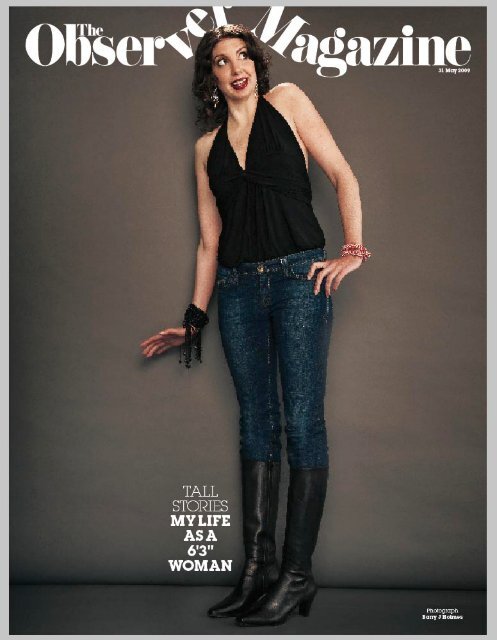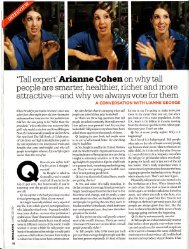You also want an ePaper? Increase the reach of your titles
YUMPU automatically turns print PDFs into web optimized ePapers that Google loves.
CREDIT I<br />
have a theory that we each have a vague kinship<br />
with an exotic animal. Perhaps you have an<br />
in explicable affinity for leopard print. Or your<br />
shower curtain is covered in butterflies, similar to<br />
the one on your ankle. Or you were a Rubenesque,<br />
somersaulting toddler and your family nicknamed<br />
you Panda.<br />
For me it is the giraffe. My career as a longnecked<br />
mammal began at a supermarket conveyor<br />
belt circa 1987, when a woman actually said it: “Aw.<br />
You look just like a little giraffe!” I looked up to my<br />
mother for help, but her face was hidden behind the People<br />
announcing Princess Diana’s marital woes. I was left to fend<br />
for myself. I must have looked stricken, because the woman<br />
said, “Don’t worry honey, it’s a compliment.” “Don’t worry”<br />
is code for, “You should really worry a lot about this.” The lady<br />
meant well. She was a puffin of a woman, smiling warmly<br />
down at me. Stick drawings were an accurate representation<br />
of my body that year, so I’m sure that my limbs shooting out<br />
of a jumper below a mop of brown hair did indeed resemble<br />
a baby giraffe.<br />
Up to that point, I was aware of height only insofar as I<br />
bruised my knees on my best friend Jeni’s bike handlebars,<br />
and that I shopped in the juniors section. I wasn’t concerned<br />
until adults started regularly shrieking, “My, look how tall<br />
you are!” Or, rather than looking at my never-ending fingers<br />
and saying, “Oh, a piano player,” they opted for a comparison<br />
with an African safari creature.<br />
The woman was still looking at me expectantly. I grabbed<br />
my mother’s thigh, looked at the ground and quietly said,<br />
“Thanks.”<br />
The puffin woman was firmly in line with the rest of society.<br />
In my elementary school zoo play, I was the giraffe. In<br />
sixth grade, when my science class voted on who would do<br />
reports on which animals, I got the giraffe. A decade later,<br />
as a 6ft 2in first-year undergraduate at Harvard, the annual<br />
water polo team initiation ritual took place at a jungle-themed<br />
party. While the other girls wore little black dresses (the black<br />
leopard), faux snakeskin trousers (the python), or tight red<br />
sweaters over green minis (the parrot), I wore tapioca yellow<br />
Capri pants, ears and chocolate body paint spots.<br />
Tall folk are incapable of talking about their height without<br />
discussing their family. It’s because height is one of those<br />
traits that comes with a long shadow. There’s always a history.<br />
Inheritance, you might call it.<br />
Mine begins in 1952, when my grandmother bought a<br />
baby book in which to note the developments of my mother’s<br />
childhood and began plotting my mother’s height on the<br />
growth chart provided. The result is comical: my mother’s<br />
height stubbornly refuses to stay within half a page of the<br />
chart’s clearly defined “average zone”. By age four, my grandmother’s<br />
ballpoint indentations have turned into a panic.<br />
The page is filled with erased pencil dots attempting to plot<br />
the future. The future said 6ft 2in.<br />
In 1962, my grandmother read a newspaper story about<br />
a new oestrogen treatment to propel early puberty. The idea<br />
is to force an express puberty, closing the growth plates<br />
around age 11, thereby skipping the furious years of growth<br />
at ages 12 and 13. My mother’s tall childhood was textbook:<br />
“Amazon Arline!” she was called. “Daddy Long Legs”. Ten<br />
thousand queries of “How’s the weather up there?” One<br />
of her legs was already permanently shorter than the other<br />
from her hip drop stance, where she spread her legs into an<br />
upside-down V and shifted one hip downward so the socket<br />
dropped down, shaving off three or so inches. Along with<br />
slouching, she could reduce herself by nearly five inches.<br />
The photo albums are consistent with the baby book:<br />
26 The Observer Magazine 31 May 2009<br />
a coltish girl with never-ending legs under an afro of auburn<br />
curls. Arline pouting in a slouch on family vacation. Arline<br />
pouting in a slump at school. Arline pouting in a pile at the<br />
beach. It takes the suspense out of turning the page.<br />
Which is all to say that my mother arrived at the office of<br />
the endocrinologist in a mild state of ecstasy. For the next<br />
year-and-a-half, she took an orange pill morning and night.<br />
A bevy of male doctors tracked her for signs of puberty. She<br />
had a few migraines, presumably from the hormones, and<br />
went into express puberty, gaining 30lbs in a year, as dutifully<br />
documented in the baby book’s accompanying weight chart.<br />
Her growth curve, previously a gentle sinusoidal arch, suddenly<br />
flatlined. And then treatment ended abruptly. She was<br />
5ft 11¾in, thrilled to have dodged the 6ft bullet.<br />
Of course, she was still tall, towering five inches over the<br />
5ft 7in Jacqueline Onassis, then considered statuesque. She<br />
puts it shortly: “My height was my biggest problem, it defined<br />
who I was, and it was defined negatively.” She grew into an<br />
adult who “dreams of being 5ft 5in”. She wore beige and navy,<br />
and never donned a hue that you might see in, say, a rainbow<br />
For a year and a half, my mother took an orange pill<br />
morning and night. She had a few migraines and put<br />
on 30lbs, but she was thrilled to dodge the 6ft bullet<br />
“To resist being tall is<br />
like being a non-<br />
performer pushed on<br />
stage every day”:<br />
<strong>Arianne</strong> at ??????<br />
– nor heels, ever. (The goal is to be shorter, not pretty.) If she<br />
could become the wallpaper, she would.<br />
Which is how I came to visit the endocrinologist annually<br />
from the age of three. She wanted me to have the option,<br />
because for her it had been “among the best things I’ve ever<br />
done”. For a decade I went as a matter of course. I thought<br />
everyone had an endocrinologist, like a dentist but for your<br />
growth. Just bone scans instead of tooth x-rays.<br />
The skeleton details of why I was there were revealed to<br />
me when I was 11. Which is how I found myself facing Dr<br />
Kauger, my mother, and the question: “So what height would<br />
you like to be?” I had six months to decide, because the pills<br />
must be started before puberty. I peered over Dr Kauger’s<br />
shoulder, tracing my curve to its end: 6ft 3in. Way above all<br />
the other growth curves. My mother sent me to the waiting<br />
room so she could talk with Dr Kauger. I thought things<br />
over. I was having a hard time framing my height positively.<br />
The week before I’d attended a social, a dance-cum-grouphangout<br />
where 11-year-olds hung out in the basement of my<br />
school at pool tables and a long mahogany bar that served<br />
root beer and ginger ale. I arrived early and lingered in a corner<br />
for a while in my signature stance, the hip drop. Nothing<br />
is more unattractive than the hip drop. The room lacked<br />
chairs (no one can work a chair like a tall girl), so I hovered<br />
awkwardly, towering above the cliques, unable to hear the<br />
girls and drawing zero interest from the boys.<br />
When my hips started to ache, I awkwardly strolled my<br />
5ft 7in self around the room, passing Katie and Justin, a year<br />
older, at a pool table. My brain has blocked out the precise<br />
phrasing of what they said, but the gist was: “No one likes<br />
you, you look like a giraffe, and no boy will ever date you.”<br />
The problem with tall teasing is that, unlike most teasing,<br />
it’s 100% accurate. I really did look like a giraffe. So obviously<br />
they were right. At least my mother was on my side. She had<br />
smartly overloaded my schedule with activities where height<br />
was an asset – tennis, dance, swimming.<br />
In Dr Kauger’s waiting room, I watched adorable chemostunted<br />
boys and girls play below walls muralled with giraffes.<br />
Children’s illustrators often employ giraffes as a neutral mascot<br />
of difference. “Because of its height, the giraffe has long<br />
been a symbol of people who just don’t fit in,” writes Lynn →
31 May 2009 The Observer Magazine 27
“You do not have a tumour,” said Dr Singh. But I had<br />
just spent eight days contemplating death… “They<br />
thought your pancreas was too large. You are just<br />
← Sherr, the tall American news anchor who was so intrigued<br />
by her own lifelong association with giraffes that she took<br />
time off to write a book about them, Tall Blondes. “They may<br />
be too tall or too eccentric, or simply too different from everyone<br />
else, like exclamation points on the landscape.”<br />
Exclamation point. That is exactly. What. I felt like. !<br />
I was the sort of child who read the op-ed page, so I<br />
thought that perhaps there might be a book to help me make<br />
my decision. That afternoon I went to the library. The card<br />
catalogue said, “Tall: see Giraffe”. No mention of “oestrogen”<br />
or “height reduction treatment”. From Memily, by children’s<br />
writer Stephen Cosgrove: “Week after week, Memily grew<br />
and she became sadder and sadder. She was shy and embarrassed<br />
by her height, and whenever any of the other creatures<br />
walked by she would turn her head, knowing that they had to<br />
look up just to look her in the eye.” Memily develops a severe<br />
slouching problem. So did I.<br />
But Memily, apparently, was never offered oestrogen therapy.<br />
So I had to make the decision alone. My thinking had<br />
little to do with height and more to do with a general aversion<br />
to medication: when in doubt, don’t take chemicals. At<br />
the time, it was simply a decision of passivity. I was frozen.<br />
Though I wasn’t happy with my body, I didn’t want to change<br />
it. I told myself that the fastest swimmers in the world were<br />
six-footers. Long limbs were important. So I decided to not<br />
do anything. I figured I’d just wait and see what happened.<br />
What happened is I ended up on the couch of therapist<br />
Diane, my gawky 17-year-old limbs sprawled awkwardly. My<br />
mother sent me as a precautionary measure, concerned that<br />
I wasn’t talking much. But really, I just didn’t want to talk<br />
about my life as an exclamation point. I mean, what was there<br />
to say? Boys ignored me. My closest resemblance was to Big<br />
Bird. There wasn’t enough happening to fill light pleasantries,<br />
let alone an hour of analysis.<br />
So we talked about my mom. This is what therapists do:<br />
untangle women from their mothers. One day I announced<br />
that I didn’t think my familial height was particularly feminine.<br />
Diane gamely insinuated that perhaps this was just one<br />
perception. Mine.<br />
She asked me how I felt about my body. I looked down at<br />
Caption in here<br />
please to fill this<br />
space over two lines<br />
Caption in here<br />
please to fill this<br />
space over two lines<br />
This is appropriate<br />
dummy text that is<br />
myself on the couch, lean and tanned from hours of daily<br />
swimming. As bodies go, even then, mine sort of did what it’s<br />
supposed to do. Length is a great friend of thighs and tummies<br />
– it stretches them, taking the eye away from the bulges.<br />
And I could wear pretty much any style – glam, boho, sporty,<br />
chic. Tallness is, objectively speaking, gorgeous. Tallness, by<br />
definition, can only be awkward when there are other bodies<br />
nearby. You see it at basketball games: the 6ft 5in athlete<br />
looks ethereal in her own space, all grace and long angles.<br />
And then the 5ft 5in teammate comes into the frame, and<br />
suddenly she looks like Hulk. Or the shorter teammate looks<br />
like Humpty Dumpty. Ditto on catwalks when the designer<br />
appears. Sitting on the couch alone was great.<br />
“So,” Diane asked, “where’d you get the idea that you<br />
weren’t feminine?”<br />
The true challenge of tall life is not that you’re tall. Who cares<br />
about that – legs are legs. The challenge is that everyone can<br />
see you, all the time. Eyes follow everywhere you go. You’re<br />
public. On display. There is no hiding. Learning to love yourself<br />
has nothing to do with the blather you see in women’s<br />
magazines about treating your body as a temple; it’s learning<br />
to accept the high-wattage spotlight that came packaged with<br />
your body, always shining on you. I can tell you what it feels<br />
like to resist: like a non-performer pushed on stage, day after<br />
day. The giraffe in the room.<br />
Shortly after college, I headed off for a journalism job in<br />
Cambodia, one of the shortest countries in the world, where<br />
men average 5ft 4in, and women below 5ft. If you want to<br />
know why I chose Cambodia, I can only say that I had just<br />
spent four undergraduate years at Harvard, where students<br />
are quite tall, and I’d melded in for the first time. Thus,<br />
height wasn’t on my mind when I chose my next step.<br />
I spent much of my time in Phnom Penh attending press<br />
conferences where I walked into meetings to find 50 men<br />
and 20 cops milling around, the tallest of whom reached my<br />
armpit. All stared. I never quite figured out how to socially<br />
manage this situation.<br />
I was the tallest person anyone had ever seen. Taller than<br />
the locals, taller than the expatriates. I assumed that after<br />
months of frequenting the same markets with the same<br />
saleswomen, they would eventually get over it. Never happened.<br />
Every time I entered a market or passed any Cambodian,<br />
I ran a 75% chance of hearing, “Bpee metres!” (“Two<br />
metres!”) followed by a swift sucking in of breath. I was considered<br />
so tall, and therefore exotic, that I didn’t get a gender<br />
– I was just an enormous barang (foreigner), a sort of uberlarge<br />
white mutant.<br />
Tall hazards are never quite what you expect. One Monday<br />
I awoke in Phnom Penh with a bit of stomach pain<br />
and soon found myself on a plane to Bangkok General for<br />
an emergency appendectomy. The surgery went smoothly<br />
and I landed in an extra-long bed on the Foreigner Floor. A<br />
nurse handed me my belly button ring, which had apparently<br />
caused 15 minutes of operating room commotion.<br />
The resident English-speaking doctor, the green-turbaned<br />
Dr Singh, explained that my surgery had been successful.<br />
Then he informed me that they had found an “unspecified<br />
mass” on my pancreas. He wanted to let me rest and then<br />
perform another CAT scan the following day, focusing on<br />
the pancreas. He also ordered blood work to look for tumour<br />
markings. He held up an MRI image of my pancreas and<br />
pointed to where it should end. Mine extended 6in past his<br />
finger. He said it could just be inflammation, but that he’d<br />
asked the nurses not to mention it.<br />
I knew perfectly well that pancreatic tumours are bad<br />
news. The five-year survival rate is 3%. But I consoled →<br />
31 May 2009 The Observer Magazine 29
← myself with the freeflowing morphine and the knowledge<br />
that I would have an answer soon.<br />
While I pondered the fact that I was potentially dying of<br />
pancreatic cancer, Dr Singh took a five-day trip to China. I<br />
was put on the Foreigner Diet, which consisted of cream of<br />
corn soup breakfast, cream of chicken soup lunch and, one<br />
night, cream of cream. Then the CAT scan machine broke.<br />
Despite this, too-young nurses starved me every night in<br />
preparation for morning CAT scans that never materialised.<br />
I was so bored that I watched Showgirls in Chinese.<br />
When you think you have a terminal illness at 23, this is<br />
what you do: first, you want to wave a wand to make your problems<br />
go away. You poke at your pancreas, and wonder why you<br />
can’t just reach through the skin and fix it. Then you remind<br />
yourself that you will never have sex again, and that the rest of<br />
your life will be painful, boring and short. It was over.<br />
On day seven, a relaxed-looking Dr Singh appeared. I was<br />
very hungry, having fasted yet again. He was smiling: “Good<br />
news, your tumour indicators were within normal limits,<br />
and your CAT scan was fine. You do not, my dear, have a pancreatic<br />
tumour.”<br />
I tried to convey my best “I just spent eight days contemplating<br />
my own death” look.<br />
He explained that in the basement the radiologists review<br />
the X-rays and scans, and they have little charts glued to the<br />
wall telling them how many centimetres each organ should<br />
be. “My dear, as you know, you are very tall. So, I think that<br />
maybe they looked and thought your pancreas was very large<br />
for a Thai person. You probably had a bit of pancreatitis too,<br />
but you are OK now.” I glared.<br />
“You do not have a tumour, my dear,” he smiled. “You are<br />
just very tall.”<br />
Cambodia was my one respite from giraffes. Southeast<br />
Asians don’t really know what they are. But had I known<br />
what I know now about giraffes, I would have missed their<br />
presence in my life. Giraffes are tall, laid-back creatures<br />
of the highest order: polysocial, known for hanging out in<br />
any number or gender combination, the cool lunch table.<br />
They stand lookout among the zebras and wildebeests and<br />
ostriches, and get along with the entire savannah. They are<br />
anything but outcasts.<br />
Giraffes come in all the hair colours I have tried – red, black,<br />
brown and blonde – and their hooves are the size of dinner<br />
plates, their eyes wider than a spread hand. The word comes<br />
from the Arabic zarafa, which means to hurry, something<br />
at which they are more awkward than the most awkward<br />
tall person you’ve ever seen. They move both right legs<br />
and then both left legs to prevent tangles. At 18 feet tall,<br />
their ability to get a drink and not black out is studied<br />
by Nasa scientists. They are nuts for routine. If the<br />
daily schedule changes, they turn into Rainman.<br />
Our interest in them is intriguing, because<br />
giraffes are the rare creature that serve no purpose<br />
to us. We can’t eat them or make clothes out of them<br />
or use them for labour. They’re not even all that<br />
entertaining (see penguins). Basically, we like them<br />
because they’re tall.<br />
I saw this during my brief stint as one half of America’s<br />
tallest couple, with my 7ft 2in partner, Alan. We<br />
met at the European Tall Club convention, where I’d<br />
gone to report for my book. And as I watched people<br />
interact with him, what I saw was that people really<br />
loved him. Toddlers make a beeline for him; adults<br />
want to sit at his table; friends sort of burrow into<br />
his side; at parties, the space next to him is always<br />
filled. He gets a lot of hugs. From everyone. Men,<br />
30 The Observer Magazine 31 May 2009<br />
“Some of the most<br />
life-changing advice<br />
ever”: <strong>Arianne</strong><br />
began seeing shorter<br />
men when she was<br />
accused of being<br />
prejudiced by only<br />
dating up<br />
women, children, elderly. They could never articulate why.<br />
I found the answer in a 1969 book on giraffes by CAW<br />
Guggisberg: “Humans are awed and deeply stirred by anything<br />
that is big. A monumental building, a big ship or a towering<br />
mountain all give us a thrill, and this may account for<br />
the tremendous interest people have always taken.” People<br />
love tall. I didn’t believe it until I saw it with my own eyes.<br />
In researching The Tall Book, I found that, without fail, children<br />
absorb their parents’ feelings about their height. Just as one<br />
learns from one’s parents a suitable wedding gift and what<br />
appropriate make-up and jewellery looks like, one also finds<br />
one’s adult self ingrained with a sense of what bodies are<br />
appropriate. And I felt that to be tall was not appropriate.<br />
Susie Orbach puts it differently: “If parents are tall and<br />
uncomfortable, then children will feel that part of being tall<br />
is to be out of sorts, to be peculiar in some way. So they will<br />
feel like they are ill-fitting in a profound sense.”<br />
Which is how I ended up at the European Tall Club Convention,<br />
on the arm of the man who negated any sense that<br />
I was on display – more than any other man on earth. When<br />
we went for walks, people either stared at him or at my dog.<br />
In my journal I wrote, “Ignored again! Fascinating!”<br />
I had never dated anyone shorter than me. I spent my time<br />
seeking out the 3.9% of men taller than me. I was alerted to<br />
the error of my ways while interviewing love and relationships<br />
expert Dr Betty Dodson. When I told her that I only<br />
dated up, she exclaimed, “Oh you’re prejudiced? I mean,<br />
come on! Develop a sense of humour! It will help. Look in the<br />
mirror and say, ‘God damn, we’re a weird-looking couple.’<br />
And then shut it off.”<br />
This was among the most life-changing advice I’ve ever<br />
received. Because she’s not talking about height. She’s talking<br />
about the way in which we all unwittingly corner ourselves<br />
by whittling down our options. Perhaps you only date<br />
or befriend people who are your ethnicity, or have a certain<br />
body type, or are overly educated, or in a certain field. And<br />
poof, just like that 90% of your pool disappears.<br />
Height makes a great case study, because height statistics<br />
are easily quantifiable. Tall women have half the birth rate<br />
of shorter women. “It’s not related to lower fertility,” says<br />
anthropologist Boguslaw Pawloski, the pre-eminent mating<br />
patterns researcher. “The problem is their lower chances of<br />
finding a partner. It’s the same with short guys. They are<br />
not limited by sperm quality or hormone level – they’ve got<br />
problems with finding a partner.” In the population at large,<br />
women typically date men who are 8% taller. This is a boon<br />
for the women below the 50th percentile, who have 99 per<br />
cent of men to choose from. A woman at 6ft 3in, like me, is<br />
looking at under 3% of the male population. Extrapolate<br />
freely to the choices you make in your own life.<br />
I had six months with Alan to let Dodson’s words<br />
marinate before the relationship imploded. The<br />
truth was that despite getting along famously, we<br />
had little in common. No tall joke could save us. And<br />
in the two years since, I haven’t kissed anyone taller<br />
than me. Don’t get me wrong, they’re still tallish – the<br />
6ft DJ, the 5ft 11in triathlete, the 6ft 1in actor.<br />
Giraffes have incredible vision, able to identify people<br />
or animals one mile away. This is also metaphorically<br />
true. To be different is to see more. And in my burgeoning<br />
singledom, I saw that perhaps I should look slightly<br />
downward from time to time. I did, and a whole new<br />
world opened up – one a little closer to the ground.★<br />
<strong>Arianne</strong> <strong>Cohen</strong> is the author of The Tall Book: A Celebration of<br />
Life on High, published by Bloomsbury. OFFER TTKKKK








